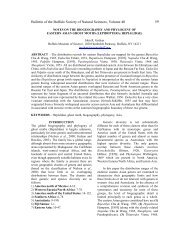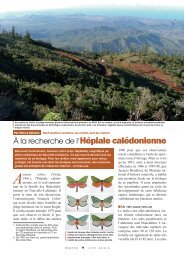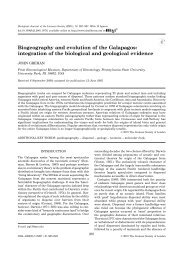You also want an ePaper? Increase the reach of your titles
YUMPU automatically turns print PDFs into web optimized ePapers that Google loves.
Caesalpinia bonduc (Caesalp.; widespread in tropical areas) is a liane or scrambling shrub of<br />
coastal thickets and forest, sometimes occurring in mangrove or on limestone.<br />
Derris trifoliata (Faba.; East Africa to Tonga/Samoa) is a scrambling liane frequent near the<br />
sea in thickets or forest edge vegetation, sometimes on limestone cliffs or the edges of<br />
mangrove swamps.<br />
Mucuna gigantea (Faba.; India to Societies/Hawaii) is a high climbing liane usually in<br />
coastal thickets, sometimes recorded from mangrove edge.<br />
Canavalia sericea (Faba.; Micronesia to eastern Polynesia) is a prostrate or scrambling vine<br />
on beaches, along rocky coasts or in coastal thickets, and sometimes on limestone.<br />
Vigna marina (Faba.; pantropical) is a prostrate, scrambling or twining perennial herb on<br />
beaches, sand dunes and thickets, and sometimes on limestone.<br />
Barringtonia asiatica (Barrington.) is one of the most characteristic and largest beach trees<br />
and can be associated with mangrove and limestone. Its trunks often lie out over the beach.<br />
Lumnitzera littorea (Combret.) in Fiji is a mangrove tree 3-9 m tall, often compact or<br />
spreading, or a shrub 2 m tall. Tomlinson (1986) noted its tendency to develop a diffuse,<br />
sprawling habit, with the lower branches frequently taking root.<br />
Pemphis acidula (Lythr.; East Africa to eastern Polynesia) is a gnarled or compact shrub or<br />
tree and has been described as ‘somewhat intermediate between a strand plant and a mangrove’<br />
(Tomlinson 1986). It is most characteristic of coastal thickets and limestone cliffs. In New<br />
Guinea (e.g. Madang, pers. obs.) plants form plagiotropic mats 20-30 cm high and a metre<br />
across hugging eroded limestone in the spray zone. The habit of these plants closely resembles<br />
that of alpine shrubs.<br />
Maytenus vitiensis (Celastr.; Fiji to eastern Polynesia) is a scandent shrub or small tree, of<br />
beach thickets, dense, dry or secondary forest, often on limestone and sea cliffs.<br />
Salacia pachycarpa (Hippocrat.; Fiji and Tonga) is a liane, often high-climbing in dense<br />
forest, sometimes on limestone.<br />
Colubrina asiatica (Rhamn.; East Africa to eastern Polynesia) is a scrambling or scandent<br />
shrub or small tree in beach thickets and dry forest, sometimes on limestone.<br />
Rhamnella vitiensis (Rhamn.; New Guinea to Tonga) is a gnarled tree, scandent shrub or<br />
liane. It occurs near sea level on rocky shores and cliffs, including limestone, up to 550 m.<br />
Smythea lanceata (Rhamn.; Seychelles – Fiji) is a liane or sprawling scandent shrub. It<br />
occurs near sea-level only, along beaches, at the edge of tidal marshes, along streams behind<br />
mangrove swamps, and in river bank thickets.<br />
Hiptage myrtifolia (Malpigh.; Fiji endemic) is a shrub or small tree, usually with scandent<br />
braches, or a high-climbing liane of dense, dry or secondary forest, sometimes on limestone.<br />
Ximenia americana (Olac.; pantropical) is a tree, sometimes spreading and often gnarled, of<br />
coastal habitats, sometimes on the edge of mangrove and on limestone. It has both<br />
brachyblasts, and long shoots determinate by abortion (pers. obs. in New Ireland) and thus the<br />
architecture is ‘divaricate’ (Heads 1998 – it is one of the very few divaricate plants in Fiji or<br />
Papua New Guinea).<br />
Geniostoma calcicola (Logan.; S Lau: Fulaga). is a scandent shrub known only from<br />
limestone cliffs near sea level. Other Fijian species of Geniostoma are erect plants ranging up<br />
to 1240 m altitude.<br />
Melodinus glaber (Apocyn.; Fiji and Vanuatu) is a high-climbing liane, sometimes growing<br />
with mangroves.<br />
29









